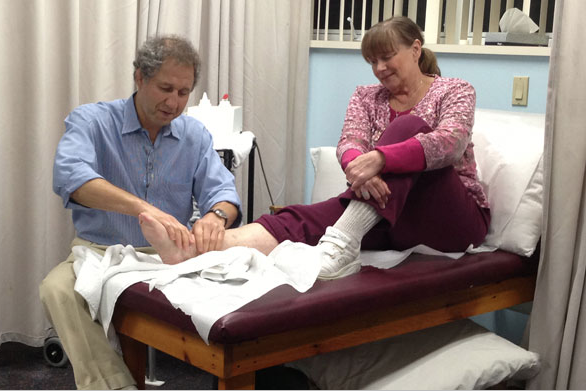By Rob Ziegelbaum
As we get older, our bodies undergo changes that play a role in how we go about our lives. Tasks that were previously commonplace may present more of a challenge.
However, that is not to say that we can’t adapt. Physical therapy can play a crucial role in how we tackle the marathon of aging. Performing transfers like standing up from a chair, reaching into cabinets and walking in the community are things that the younger population may take for granted — in the rehab world we refer to these as activities of daily living.
With the guidance of a physical therapist, increased independence during ADLs can be either re-attained or made sustainable for the long term.
A very common complaint from elderly patients is difficulty standing up from a chair or sofa in their homes.
While there are many reasons why the transfer can present difficulty, several steps can be performed to increase efficiency.
Strengthening your legs under the guidance of a PT is a good place to start.
In addition to strength, putting yourself in a position to succeed is crucial; patients are coached in the “nose over toes” method.
The first instruction in the transfer is to slide to the edge of the chair and bring their feet back towards the seat. The next part lends itself to the name of the method – lean forward, such that a person’s nose is on top of their toes.
This shift forward increases a person’s ability to stand up. Across all body parts, range of motion and strength are critical in increasing an individual’s level of function.
Our shoulders are one of the most mobile joints in our bodies.
The large range of motion that our shoulders are capable of allows us to do a wide variety of tasks. The muscles in our shoulders — such as the rotator cuff muscles—are critical in stabilizing our shoulders through motions in our day-to-day lives.
As we get older and perhaps slightly less active, muscle strength can diminish. The decrease in strength in the shoulders can then become a limiting factor in an individual’s ability to perform functional tasks such as lifting a carton of milk and placing it in the refrigerator.
A PT can instruct a patient in a proper strengthening regiment to address deficiencies a person may have in their strength.
Isometric rotator cuff exercises are often the starting point in a strengthening program. Isometric exercises are safer initially in that the patient is in total control of the amount of force exerted without adding resistance.
An added perk of these exercises is they don’t require equipment, so they can be done anywhere!
A common problem people in the elderly population face is difficulty walking and balance issues. A fear of falling is a legitimate and real problem.
Physical therapists can aid in reducing the risk of falls through a variety of methods. In order to maintain our balance, our bodies rely on three systems: vision, sensation and our vestibular system located in our inner ear.
To remain upright, we need two of the three to be functioning properly.
Physical therapists can assist with deficits in all three areas, but we will hone in on sensation.
As people age, the nerves furthest away from our core become less efficient in transferring information to the brain. These nerves are called peripheral nerves.
When peripheral nerves in the feet are affected, as often is the case in the elderly population, messages about where the feet are in space are lost and balance is affected.
PTs can’t stop this aging process, but can facilitate something known as neuroplasticity. Neuroplasticity is an amazing phenomenon that our brains are capable of wherein the body subconsciously finds nerves that are functioning properly to pick up the slack for others that are lagging behind. One way to do this in terms of balance is through exposure.
A PT will perform supervised weight shifting in all directions to allow the individual to feel their body move in space without the risk or fear of falling.
Cues for mechanics during ambulation are also crucial to increase safety and independence when walking on all surfaces.
A solid program for balance strategies coupled with leg strengthening and gait mechanics can greatly affect a person’s ability to walk or stand with confidence while performing ADLs.
Getting older comes with a multitude of changes, but with the guidance of a PT the transition can be a smooth one.
A supervised treatment plan and an appropriate home exercise program can be a huge asset in increasing independence. Aging is a privilege, and the human body is capable of incredible things – take advantage!
Information provided by Rob Ziegelbaum PT, DPT, TPI, Clinical Director/Physical Therapist at Zelik Ziegelbaum Physical Therapy, www.ZZ-PT.COM



